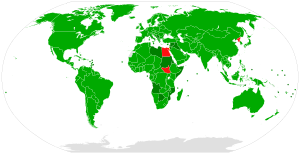The chemical Weapon Convention (CWC) applies measures to restrict various chemicals in international trade. These restrictions are directly on dual-use chemicals. Dual use chemicals are those which have use in commercial industry but at the same time can also be used to manufacture chemical weapon. Example Thiodiglycol, used in felt-tip pens but also a precursor to mustard gas.
Chemical Weapon Convention (CWC) has three schedules of toxic chemicals and precursors ( see list of chemicals at the end of this article)
Schedule 1: High risk chemicals which have no use in the commercial industry.
Schedule 2: Toxic chemicals having significant risk; not generally produced commercially in large quantities.
Schedule 3: Toxic chemicals produced large scale commercially for legitimate purposes but also have potential to be used in chemical weapons.
For the purpose of transport of samples of chemicals taken for analysis in connection with the implementation of the Convention on the Prohibition of the Development, Production, Stockpiling and Use of Chemical Weapons and on their Destruction, entry in IMDG Code UN 3315, CHEMICAL SAMPLE, TOXIC, Class 6.1 may be used.
Chemical sample may only be transported provided prior approval has been granted by the competent authority or the Director General of the Organization for the Prohibition of Chemical Weapons.
For full details on transport of samples under above mentioned purpose refer entry UN 3315 in IMDG Code and visit http://www.opcw.org/
| Schedule 1:A. Toxic chemicals1) O-Alkyl (≤C10, incl. cycloalkyl) alkyl (Me, Et, n-Pr ori-Pr)-phosphonofluoridatese.g. Sarin: O-Isopropyl methylphosphonofluoridateSoman: O-Pinacolyl methylphosphonofluoridate2) O-Alkyl (≤C10, incl. cycloalkyl) N,N-dialkyl (Me, Et, n-
Pr or i-Pr) phosphoramidocyanidates e.g. Tabun: O-Ethyl N,N-dimethyl phosphoramidocyanidate 3) O-Alkyl (H or ≤C10, incl. cycloalkyl) S-2-dialkyl (Me, Et, n-Pr or i-Pr)-aminoethyl alkyl (Me, Et, n-Pr or i-Pr) phosphonothiolates and corresponding alkylated or protonated salts e.g.VX: O-Ethyl S-2-diisopropyl-aminoethyl methyl phosphonothiolate 4) Sulfur mustards: e.g. 2-Chloroethylchioromethylsuifide Mustard gas: Bis(2-chloroethyl)sulfide Bis(2-chloroethylthio)methane Sesquimustard: 1,2-Bis(2-chloroethylthio)ethane 1,3-Bis(2-chloroethylthio)-n-propane 1,4-Bis(2-chloroethylthio)-n-butane 1,5-Bis(2-chloroethylthio)-n-pentane Bis(2-chloroethylthiomethyl)ether O-Mustard: Bis(2-chloroethylthioethyl)ether 5) Lewisites: e.g. Lewisite 1: 2-Chlorovinyldichloroarsine Lewisite 2: Bis(2-chlorovinyl)chloroarsine Lewisite 3: Bis(2-chlorovinyl)arsine 6) Nitrogen mustards: e.g.HN1: Bis(2chloroethyl)ethylamine HN2: Bis(2-chloroethyl)methylamine HN3: Tris(2-chloroethyl)amine 7) Saxitoxin 8) Ricin B. Precursors 9) Alkyl (Me, Et, n-Pr or i-Pr) phosphonyldifluorides e.g. DF: Methylphosphonyldifluoride 10) O-Alkyl (H or ≤C10, incl. cycloalkyl) O-2-dialkyl (Me, Et, n-Pr or i-Pr)-aminoethyl alkyl (Me, Et, N-Pr or i-Pr) phosphonites and corresponding alkylated or protonated salts e.g.QL: O-Ethyl O-2-diisopropylaminoethyl methylphosphonite 11) Chlorosarin: O-Isopropyl methylphosphonochloridate 12) Chlorosoman: O-Pinacolyl methylphosphonochloridate |
Schedule 2:A. Toxic chemicals1) Amiton: O,O-Diethyl S-[2-(diethylamino)ethyl] phosphorothiolate and corresponding alkylated orprotonated salts2) PFIB: 1,1,3,3,3-Pentafluoro-2-(trifluoromethyl)-1-propene3) BZ: 3-Quinuclidinyl benzilate*B. Precursors
4) Chemicals, except for those listed in Schedule 1, containing a phosphorus atom to which is bonded one methyl, ethyl or propyl (normal or iso) group but not further carbon atoms e.g. Methylphosphonyl dichloride Dimethyl methylphosphonate Exemption: Fonofos: O-Ethyl S-phenyl ethylphosphonothiolothionate 5) N,N-Dialkyl (Me, Et, n-Pr or i-Pr) phosphoramidic dihalides 6) Dialkyl (Me, Et, n-Pr or i-Pr) N,N-dialkyl (Me, Et, n-Pr or i-Pr)-phosphoramidates 7) Arsenic trichloride 8) 2,2-Diphenyl-2-hydroxyacetic acid 9) Quinuclidin-3-ol 10) N,N-Dialkyl (Me, Et, n-Pr or i-Pr) aminoethyl-2-chlorides and corresponding protonated salts 11) N,N-Dialkyl (Me, Et, n-Pr or i-Pr) aminoethane-2-ols and corresponding protonated salts Exemptions: N,N-Dimethylaminoethanol and corresponding protonated salts N,N-Diethylaminoethanol and corresponding protonated salts 12) N,N-Dialkyl (Me, Et, n-Pr or i-Pr) aminoethane-2-thiols and corresponding protonated salts 13) Thiodiglycol: Bis(2-hydroxyethyl)sulfide 14) Pinacolyl alcohol: 3,3-Dimethylbutan-2-ol |
Schedule 3:A. Toxic chemicals1) Phosgene: Carbonyl dichloride2) Cyanogen chloride3) Hydrogen cyanide4) Chloropicrin: TrichloronitromethaneB. Precursors
5) Phosphorus oxychloride 6) Phosphorus trichloride 7) Phosphorus pentachloride 8) Trimethyl phosphite 9) Triethyl phosphite 10) Dimethyl phosphite 11) Diethyl phosphite 12) Sulfur monochloride 13) Sulfur dichloride 14) Thionyl chloride 15) Ethyldiethanolamine 16) Methyldiethanolamine 17) Triethanolamine |
Related articles
- Libyan Chemical Weapons to be investigated and excess to be destroyed (jafrianews.com)
- North Korea Exported Chemical Weapon Components to Syria: Report (ibtimes.com)
- Inspectors to Check New Libya Chemical Weapons (abcnews.go.com)



 WhatsApp your queries
WhatsApp your queries
[…] Chemical Weapons – IMDG Code […]